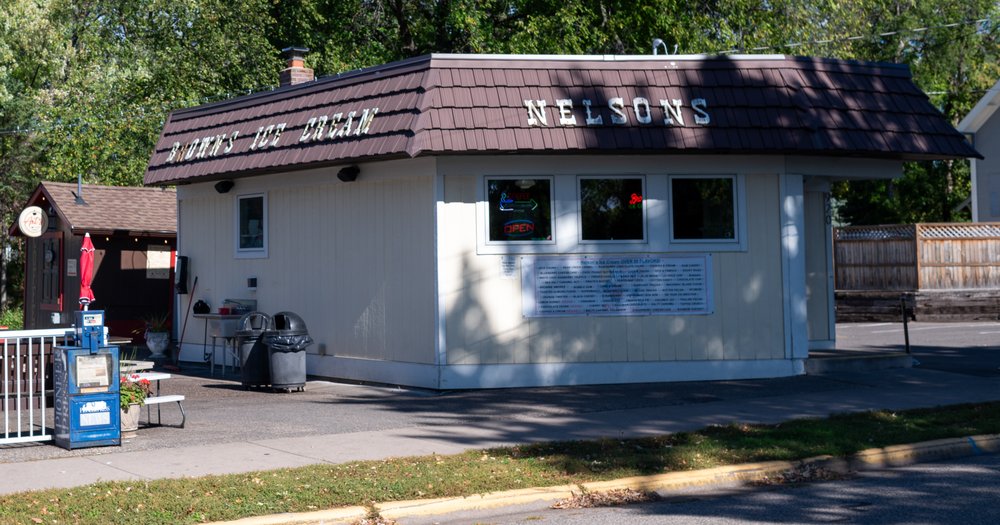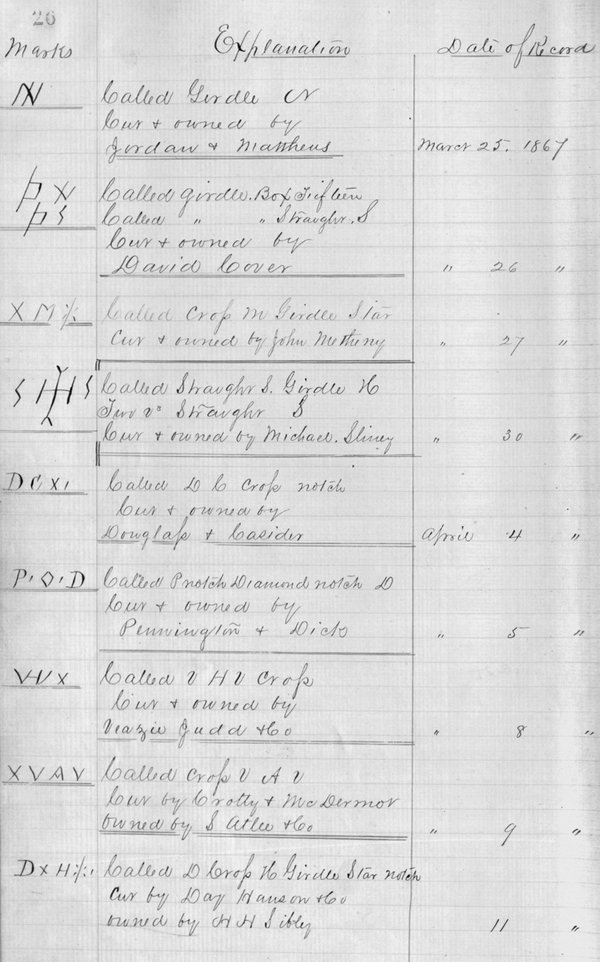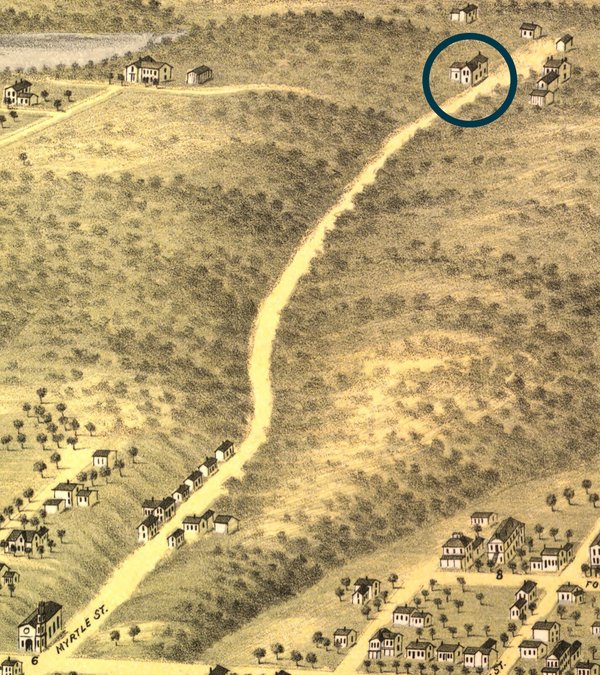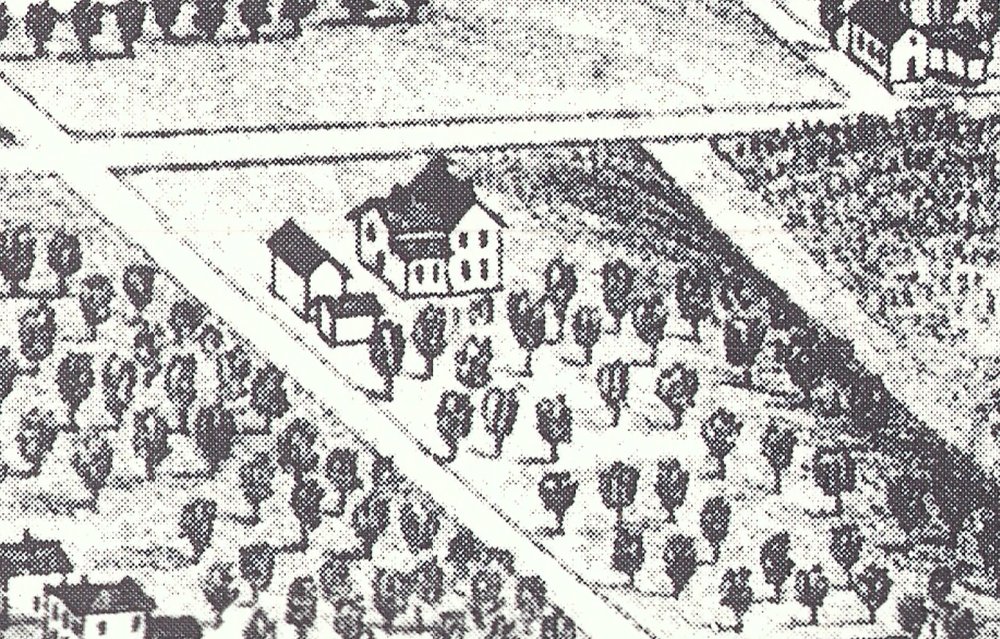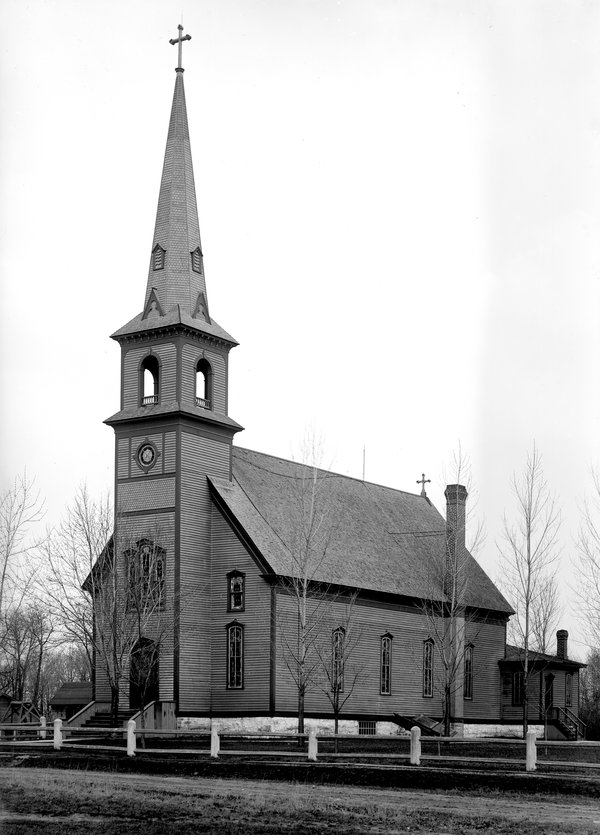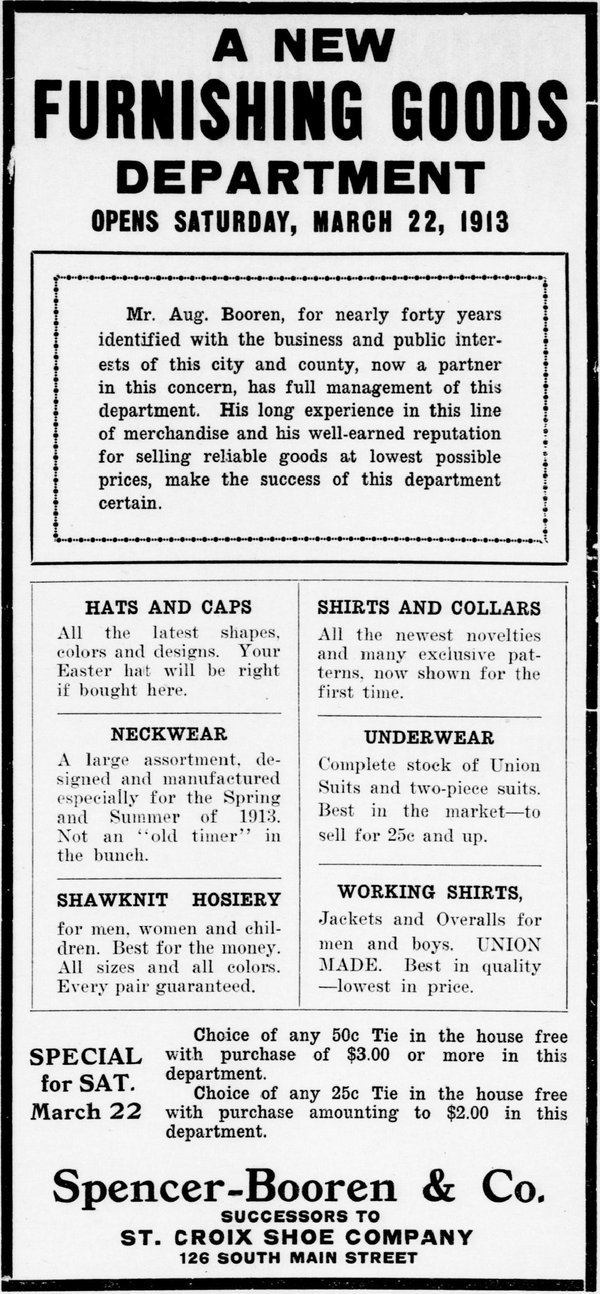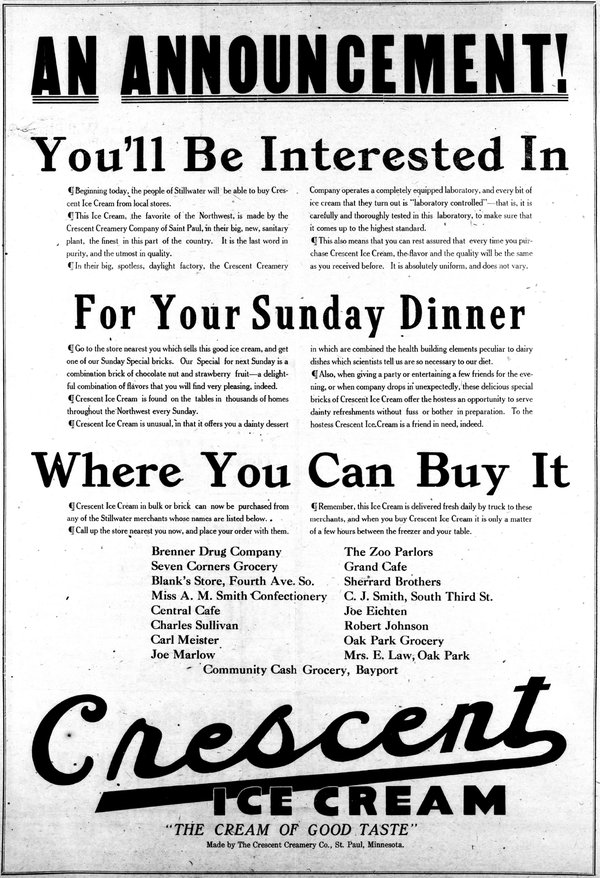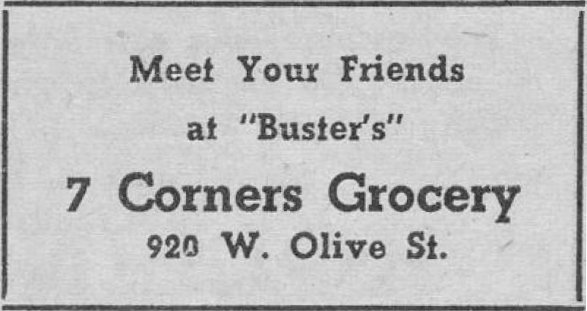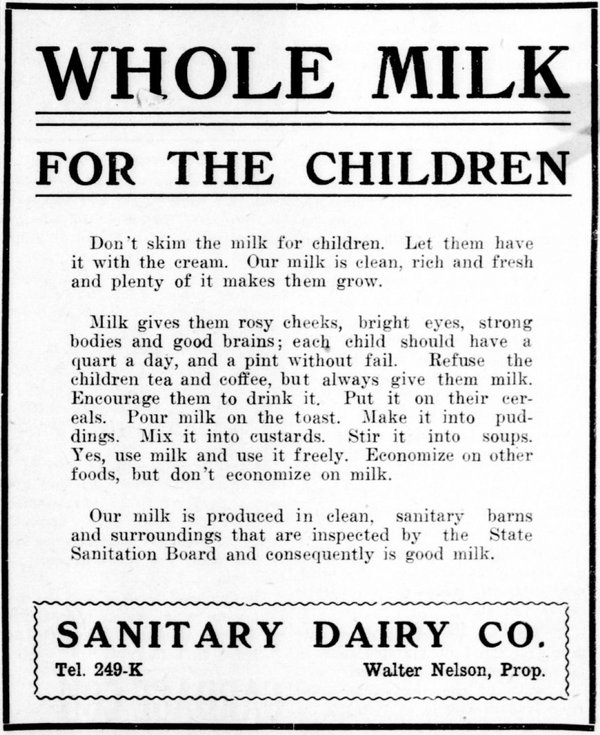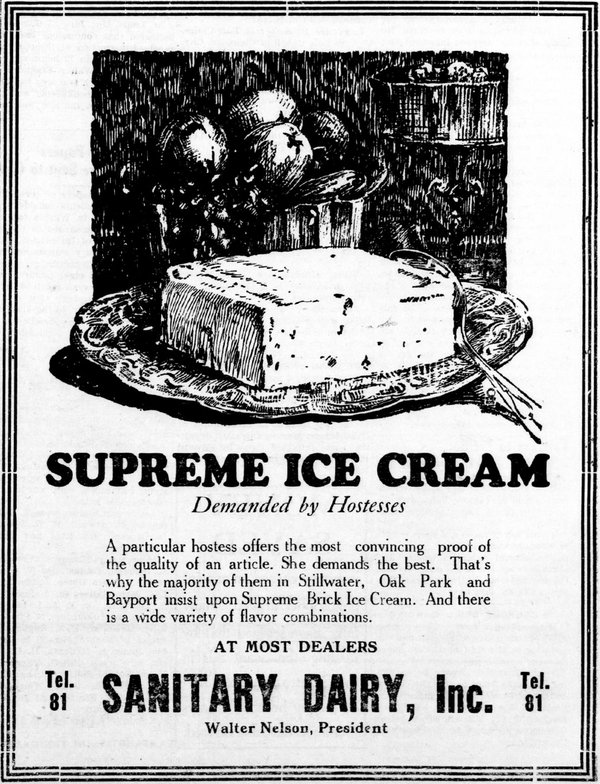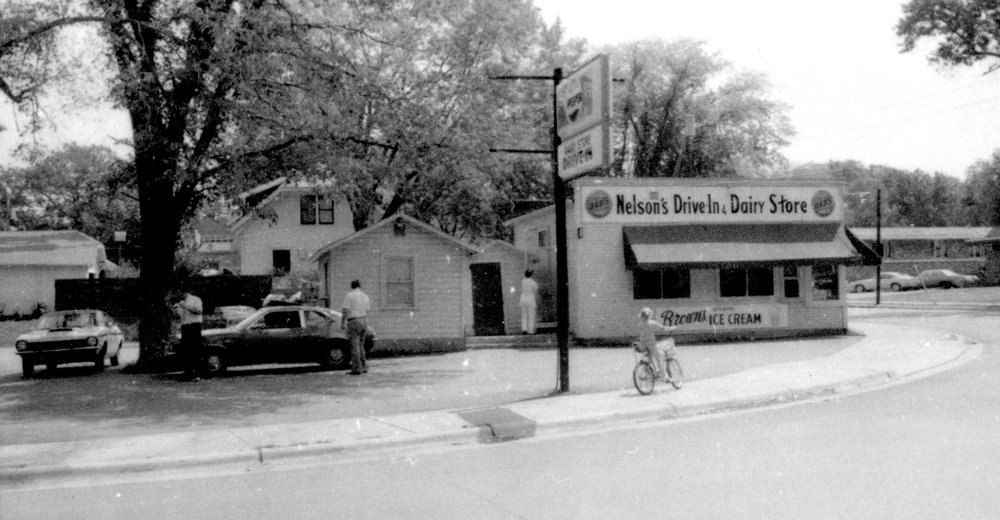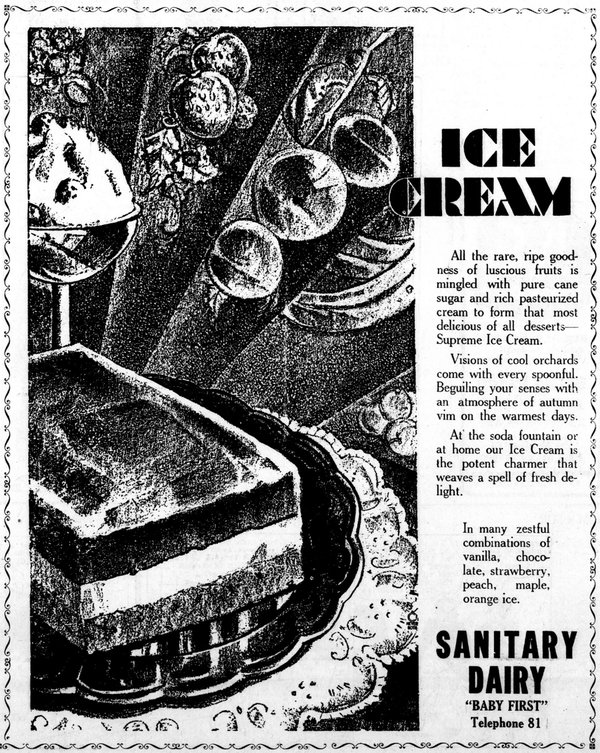Nelson's Ice Cream
From rural family home, humble neighborhood shop, and beloved ice cream institution, the location of Nelson’s Ice Cream has changed along with Stillwater over more than 160 years.
The McComb House on the St. Paul Road
Long before the ice cream store arrived, its future location was part of a rural three-acre lot, home to the James and Eliza McComb family. James was born in Pennsylvania in 1827. After arriving in Stillwater in 1846, he worked as a store clerk while also serving as a deputy sheriff. In the 1850s, James became a partner in a successful mercantile firm, constructing one of the first stone business blocks on Main Street. The future must have looked promising, and in 1854 James married Eliza McKusick. Eliza was born in Maine in 1833. At age 20, she moved west to take a job as one of the first schoolteachers in Stillwater, the town co-founded by her brother John.[1]
Unfortunately for the McCombs and most other Stillwater residents, a national economic crisis in 1857 devastated Minnesota Territory. Despite several years of success, James’ mercantile firm was one of the many businesses wiped out by the crash.[2]
After the crash, James began a second career in 1860, working in the important office of the Surveyor General of Logs and Lumber. This office measured and accounted for the vast amounts of timber floated down the St. Croix River each year. McComb developed a strong knowledge of the hundreds of marks cut to identify logs’ owners. Perhaps because of this detailed operational knowledge, the Minnesota Legislature selected James to lead the office as Surveyor General from 1867 to 1871.[3]
By 1862, the McCombs had established their home on this location. Though it is now the approximate center of Stillwater, it was a quiet and distant area when the McCombs moved here. After the house was built, Eliza’s brothers John and William McKusick continued to own the land under it, perhaps wanting to help their sister’s family after James’ business failed. The McCombs gradually purchased the land between 1864 and 1870.[4]
The McCombs’ house was at the far western end of the St. Paul Ravine, so named because the ravine formed the old road from Stillwater to St. Paul. A resident later recalled:
…the bluffs, thickly wooded, rose high on either side, and between these bluffs the old St. Paul road ran… past the old Sawyer house… past the Presbyterian church, past the residence of Martin Clancy, and then there was wilderness until you came to the residence of J.D. McComb on the left, and that of Elam Greeley, the old brick house on the right, then on out, past Barney McMinnamen’s and you are on your way to St. Paul.[5]
Another resident, Paul Caplazi, remembered that the McCombs’ house and a few others “were about all there was in that part of Stillwater in the seventies.” Caplazi recalled several small circuses setting up and performing in the McCombs’ field in the 1870s and early 1880s.[6]
By 1883, the city had grown up around the McCombs’ formerly rural lot. The couple sold their land south of Olive Street to the city’s French Catholics for the construction of St. Joseph’s Church (now the site of the nursing home and professional building). In 1885, Eliza McComb died. James continued to live in the house for another 15 years, until his own death in 1900. For a time, the McCombs’ daughter Carrie Maunsell and her husband lived in the house, but they eventually moved to Minneapolis and sold the house to Corey and Helena Spencer.[7]
The Seven Corners Grocery
The next family to live in the McCombs’ house also had a retail background. New York native Corey H. Spencer moved to Stillwater around 1900 and found work as a clerk at the Star Shoe store owned by Charles Kirk. At that time, Corey lived in an apartment above the store on Main Street. In 1903, Corey and Helena Jarchow married. The couple’s daughter, Ruth, was born the next year.[8]
When his daughter was six months old, Corey left the Star Shoe Store to manage the shoe department at Murphy & Company, Stillwater’s leading department store. When Corey’s former employer Charles Kirk retired in 1906, Corey purchased Kirk’s store in partnership with “a well known business man” who declined to be named publicly. Corey’s new company would be called the St. Croix Shoe Company.[9]
In 1912, six years after establishing their business, the Spencers decided to purchase the old McComb house for $1,000. Despite the city’s growth, the area around the ravine retained its natural beauty, and the Spencers proposed to develop it into an unofficial park at their own expense: “There is a fine grove of oak trees. [Corey Spencer] proposed to trim the trees, cut the noxious weeds and make it a spot of beauty should the city consent.”[10]
Several months after purchasing the house, Corey entered a business partnership with August Booren, expanding beyond shoes to “a complete line of gents’ furnishing goods” and renaming the company Spencer-Booren & Co.[11]
Misfortune followed. Not long after launching the expanded company, Corey became severely ill. In early 1914, after several months of Corey not being able to attend to the store, he and Booren decided to close the store and sell off their merchandise. Corey later found work as a travelling agent for Kolliner-Newman, a Stillwater clothing manufacturer. In 1916, he was in North Dakota on business when he learned that Helena had died in Stillwater after a long and painful illness.[12]
In 1919, Spencer was still working as a salesman when he decided to construct a grocery store behind his house. Perhaps he was wanted to give up traveling and spend more time around his daughter Ruth, who was 14. Spencer hired contractor Emil H. Bieging to construct a one-story store building, 20 by 30 feet and 12 feet tall. The new store faced Olive Street and was near the streetcar line on Greeley Street.[13]
Corey operated his new grocery store for less than a year before he, too, died of illness in July 1920. Ruth, now orphaned, inherited the land, house, and grocery store. Ruth’s guardian sold the property on her behalf, to Minnie J. Larson. Ruth grew up to be a Detroit art teacher but spent her summers near Stillwater on Square Lake.[14]
The new owner, Minnie Larson, lived a few blocks from the store and was married to Harry Larson, who worked as a repair man in a steel foundry. Though Minnie owned the store property, she either leased it to others to operate, or hired them as managers. The first of these was Fred Paulson, who announced he would re-open Corey Spencer’s store in September 1921 and “carry a complete line of fancy groceries for family use.” Paulson was a 46-year-old immigrant from Sweden. Like Minnie’s husband, Paulson had previously worked in a steel plant, as a timekeeper. With Paulson as manager, the store began to use the name it would carry for decades: Seven Corners Grocery.[15]
Paulson’s ownership proved to be very brief. After less than three months, he sold the business to 34-year-old Alfred Bieging. Like Paulson, Bieging had formerly worked in a steel plant, and the two may have known their landlord’s husband there. Unfortunately, Bieging’s ownership was nearly as brief as the store’s previous operators: he died about a year after he took over the store. Ellen Bieging, Alfred’s widow, continued the business for another three years. At that time, Seven Corners was one of 23 neighborhood grocery stores across Stillwater.[16]
Ice cream was likely an important offering from early days. In 1923 the Crescent Ice Cream Company of St. Paul placed a full-page ad announcing that its product would be available at Seven Corners and 16 other locations in the Stillwater area. Crescent’s ad emphasized their ice cream’s purity and consistency between batches.[17]
Starting in October 1924, the store was operated by John Lustig. Lustig, aged 50, was a longtime Stillwater resident who had suddenly lost his wife six months earlier. He had operated saloons until the arrival of Prohibition in 1920. John’s brother-in-law, Paul Gelhar, operated a small grocery store on the South Hill, and perhaps this inspired John to take over Seven Corners. Unlike all the store’s previous managers, Lustig would be a lasting presence, operating Seven Corners for more than two decades.[18]
As automobiles and electric refrigerators became more established in everyday life, the role of small neighborhood grocers changed. When John Lustig entered the business in 1924, Seven Corners was one of dozens of grocery stores, produce dealers, and butcher shops across the city. Three competing grocers were within just a few blocks of Seven Corners. By the time Lustig died 23 years later, there were 20 percent fewer of these stores in Stillwater. Groceries, meat, and produce were increasingly sold together in one-stop, self-service “complete food markets” or supermarkets. (During the same era, for example, Stillwater’s Hooley brothers transformed their grandfather’s South Hill butcher shop into a group of four “food markets,” which would later expand to become the Cub Foods supermarket chain.)[19]
With Stillwater and the grocery business changing, Seven Corners’ focus shifted during Lustig’s ownership. The original “fancy groceries for family use” concept gave way to a growing reputation for sweets. Stillwater required licenses to serve soft drinks during Prohibition, and Lustig obtained one for Seven Corners in the first weeks of his ownership. By 1927, the city directory listed Lustig’s store as a confectionary rather than a retail grocery. The following year, thieves broke into the store and took about $25 in candies, cigars, and cigarettes. “A group of boys” was suspected.[20]
Lustig continued to operate Seven Corners Grocery almost until his death in 1947. In 1948, Seven Corners was managed by George Mechelke, whose advertisements highlighted fruit, vegetables, meats, groceries… and ice cream. In 1950-51, Seven Corners advertised regularly in Stillwater High School’s student newspaper, encouraging teenagers to meet their friends at the store, nicknamed “Buster’s” or “The Hangout.”[21]
The Nelson Family
The store’s history is inseparable from the story of the Nelson family. In 1900, Danish immigrants Peter and Cristina Nelson lived at 1202 West Myrtle in Stillwater, where Peter operated a dairy. Among their several children were sons Walter and Art. Peter died in 1903. Cristina continued managing the dairy for a time, but within a few years she had remarried and moved elsewhere. After that, the dairy was apparently operated by others, though Walter continued to live in the home for a time. By 1910, Walter and Art were teenagers working as drivers for other local businesses.[22]
Around 1912, 22-year-old Walter started his own dairy on North Greeley Street, and now competed with the dairy operating in his childhood home. Two years later, Walter was back in his family’s original location, and he employed his younger brother Art as a driver. In the years that followed, Walter named his dairy the Sanitary Dairy Company and focused on offering a modern pasteurized milk product. By 1924, Sanitary Dairy was such a large operation that it significantly expanded its facility at Greeley and Olive Streets (now Just For Me Spa). This new plant, designed by Walter himself, had the capability of manufacturing ice cream and other dairy products in the future. Nelson’s new facility was considered a national model, lauded by the U.S. Public Health Service and toured by dairy owners from across the country.[23]
In 1925, Walter entered the ice cream business by purchasing the Supreme Ice Cream brand and moving its production to the Sanitary Dairy plant. Just before the Great Depression, in October 1929, Walter reported that the year’s good weather had increased Sanitary Dairy’s ice cream sales by 30 percent. Through the 1940s, Art Nelson also worked for his brother’s company as vice president and driver.[24]
In 1928, as Sanitary Dairy succeeded, the company purchased the Seven Corners store property from Minnie Larson. Walter Nelson announced plans to replace the 1860s McComb house with two new houses, and also renovate the Seven Corners store (still operated by John Lustig despite the change in building ownership). Walter and Emma Nelson moved in to one of the new houses at 904 West Olive, and their son James P. Nelson moved in to the other at 910 West OIive, with his wife Eleanor.[25]
The family’s Sanitary Dairy era came to an end in December 1947, when Walter sold the company—but not its retail stores—to Stephen Creamery Co. of Stephen, Minnesota. By the 1950s, the plant was operating as Snowland Foods. Arthur and James Nelson planned to stay with Sanitary Dairy after the sale, but Walter would retire. After selling the company, however, Walter operated the former Berglund and Peterson grocery store on North Fourth Street. By 1956, Walter had apparently truly retired.[26]
Art Nelson, however, was not yet done. In the early 1950s, he took over management of Seven Corners Grocery. He changed the store’s name to Art’s Drive In and Dairy Store, and operated it until his death in 1964.[27]
After Art’s death, the store was sold to Brown’s Ice Cream, a Minneapolis-based company owned by Wade Nelson. Wade was Walter’s son and Art’s nephew. Brown’s provided ice cream for the Stillwater store. As Wade Nelson later recalled, “I bought [Art’s] as an investment, not ever dreaming it would become the store it is. We sold cones for 10 cents—two scoops, more than a health cone. We could afford to give it to them because we were the supplier. And the place always sold a bottle of milk and a few other things, like candy.” During those years, the store would scoop out as many as 200 three-gallon containers of Brown’s ice cream during a busy summer weekend.[28]
Later Years
As Stillwater became better known as a tourist destination, Nelson’s became a regular stop for visitors. In 1989, manager Jan Young told a reporter: “On a Sunday afternoon, when we are real busy and the customer wait is long, I tell the people to talk to the person next to them. People come here from all over. It's wonderful.”[29]
By the 1980s, the Nelson family was primarily focused on Brown’s Ice Cream, leasing the Stillwater store to local managers for many years before selling the store in 1991—a few weeks after Walter Nelson’s death at age 101. Though the Stillwater store was sold, the Brown’s company remained in the Nelson family. Wade was followed in the company by his son Bob Nelson, who played football for the University of Nebraska and the 1980 Super Bowl winning Buffalo Bills.[30]
The Stillwater store’s new owners were Bob Pasket, a manager at Hooley’s Supermarket, and Chuck Kummeth, a test development specialist at 3M. Neither had heard of Nelson’s before meeting their wives, who grew up in Stillwater. Given the store’s past success, Pasket and Kummeth planned relatively few changes, including expanding the store’s hours, number of ice cream flavors, and candy offerings. The new owners planned to continue the Nelsons’ legacy by selling Brown’s Ice Cream. By 1994, the choices had expanded to 40 flavors, “including cookies and cream, licorice, toffee, blue moon, Zanzibar chocolate and the newest flavors, brown ice caramel fudge and fuzzy navel, a peach and orange combination.”[31]
After 13 years of owning Nelson’s, Pasket was living in Pine City, Minnesota. Like Minnie Larson and the Nelson family before him, Pasket had leased the store to local managers, for 11 of those 13 years. When the last local manager decided not to renew her lease in 2005, Pasket decided he couldn’t personally manage the store from his home 80 miles away. He closed the store and offered it for sale.[32]
Among those concerned about the store’s fate were Bill Bergstrom and Dave Najarian. Bergstrom recalled: “We were down here last fall and it was closed. … And we were crushed, because it’s an institution. We wanted to own a piece of history.” Bergstrom and Najarian purchased and took over the store, re-opening it in April 2006. By this time, the store was serving Cedar Crest ice cream and offering coffee drinks. Bergstrom and Najarian planned to continue the store’s tradition of extremely large scoops.[33]
In 2014, Bergstrom and Najarian established a second Nelson’s Ice Cream location at 454 Snelling Avenue in Saint Paul. “Nelson’s is an experience that evokes many fond memories for generations of families, both locally, nationally and internationally, who make it a regular destination for celebrations or just plain enjoyment,” Bergstrom told a reporter. “By expanding to another great location, we are able to offer more people convenient access to an incredible and reasonably priced ice cream experience in a family-friendly environment.” In 2021, a third location opened: Nellie’s, an ice cream sandwich shop on Marshall Avenue in Saint Paul.[34]
— Matt Thueson
Matt Thueson is a member of the Stillwater Heritage Preservation Commission.
References
-
W.H.C. Folsom, Fifty Years in the Northwest (St. Paul, MN: Pioneer Press Company, 1888), pp. 65-66. A.B. Easton, History of the Saint Croix Valley (Chicago: H.C. Cooper, 1909), vol. 1, p. 117. Eliza (McKusick) McComb obituary, Stillwater Messenger, September 19, 1885, p. 4. James D. McComb obituary, Stillwater Messenger, June 16, 1900, p. 4.
↩ -
Donald Empson, A History of the Greeley Residential Area (Stillwater, MN: Empson Archives, 1997), pp. 19-20. Folsom, p. 66.
↩ -
Easton, pp. 65-66. Minnesota Beginnings (Stillwater, Minnesota: History Network of Washington County, 1999), p. 333. James McComb obituary, Messenger.
↩ -
Washington County Assessor, Stillwater real property rolls, 1860, 1862, 1864. Q Deeds 288, T Deeds 250, U Deeds 12. (McComb’s name first appears in the assessor rolls for 1862, but the house’s value is listed in 1860. McComb’s obituary indicates that he resided in the home before 1860.)
↩ -
“Annals of The Town”, Stillwater Daily Gazette, August 2, 1927, p. 1. For more on the ravine road, see Donald Empson, A History of the Greeley Residential Area (Stillwater, MN: Empson Archives, 1997), pp. 7-11.
↩ -
Paul Caplazi, unpublished manuscript in Stillwater Public Library collection, pp. 2, 5-6.
↩ -
“The French Catholic congregation”, Stillwater Messenger, May 26, 1883, p. 4. Eliza McComb obituary, Stillwater Messenger, September 19, 1885, p. 4. James McComb obituary, Stillwater Daily Gazette, June 11, 1900, p. 3.
↩ -
Stillwater City Directories for 1900, 1902, 1904. U.S. Census for 1900. Ruth Lassettia Spencer in birth record index, Minnesota Historical Society.
↩ -
“City and Surroundings”, Stillwater Daily Gazette, February 15, 1905, p. 3. Easton, p. 266. “Star Shoe Store Change”, Stillwater Daily Gazette, October 1, 1906, p. 2.
↩ -
73 Deeds 370. “City to Borrow Needed Money”, Stillwater Daily Gazette, September 4, 1912, p. 2.
↩ -
“Embarks in Business”, Stillwater Daily Gazette, March 18, 1913, p. 3.
↩ -
“Retire From Business”, Stillwater Daily Gazette, January 14, 1914, p. 2. Stillwater City Directory for 1914. “Mrs. Spencer Passes”, Stillwater Messenger, February 12, 1916, p. 1.
↩ -
Stillwater City Directory for 1919. Building Permit Application 1743 for C.H. Spencer, City of Stillwater accessed via Minnesota Digital Library. Russell L. Olson, The Electric Railways of Minnesota (Hopkins, Minnesota: Minnesota Transportation Museum, 1976), p. 84.
↩ -
“Cory H. Spencer is Called to Great Beyond Early Saturday Evening”, Stillwater Daily Gazette, July 26, 1920, p. 1. Corey H. Spencer and Ruth L. Spencer in 1920 U.S. Census for Stillwater, Minnesota. Merrill E. Jarchow, Casey (Northfield, MN: Carleton College, 1993), p. 5.
↩ -
“New Grocery Store”, Stillwater Daily Gazette, August 24, 1921, p. 5. Fred Paulson, 1920 U.S. Census for Stillwater. Seven Corners Grocery listed in Atwood coffee ad, Stillwater Daily Gazette, September 28, 1921, p. 2.
↩ -
“Buys Grocery Store”, Stillwater Daily Gazette, November 14, 1921, p. 5. 1924 City Directory.
↩ -
“An Announcement”, Stillwater Daily Gazette, April 20, 1923, p. 10.
↩ -
1919 and 1924 City Directories. “City and Surroundings”, Stillwater Daily Gazette, October 14, 1924, p. 5. 1885 Minnesota State Census (Hattie and Paul Gelhar). 1920 U.S. Census. “Death of Mrs. John Lustig”, Stillwater Daily Gazette, April 24, 1924, p. 1.
↩ -
1924 and 1948 Stillwater City Directories. “South Hill Market”, Stillwater Post-Messenger, September 10, 1936. “The Supermarket: Early Development of an Institutional Innovation”, Journal of Retailing, v. 48, pp. 39-53, spring 1972.
↩ -
“Signs Asked as Warning to Motorists” [includes Lustig soft drink license], Stillwater Daily Gazette, October 22, 1924, p. 1. 1927 City Directory. “Store Robbed; Auto Stolen”, Stillwater Daily Gazette, December 10, 1928, p. 1.
↩ -
1942, 1945 and 1948 City Directories. Brent T. Peterson, Stillwater: The Next Generation (Stillwater, Minnesota: Valley History Press, 2004), p. 49. Advertisements, Stillwater High School Arrow, October 27, December 1, and December 22, 1950; March 9 and April 13, 1951.
↩ -
Peter and Cristina Nelson household, Stillwater (Ward 3), Minnesota, 1900 United States Census. 1900 City Directory. 1904 City Directory. “City and Surroundings” [Christina Nelson marrying Soren Sorenson Stone], Stillwater Daily Gazette August 28, 1905, p. 3. 1906 City Directory. 1910 City Directory.
↩ -
1914 City Directory (Walter and Arthur Nelson). 1919 City Directory (Walter Nelson). “Sanitary Dairy Now Building New Creamery”, Stillwater Messenger, May 28, 1924, p. 1. “Sanitary Dairy Has $30,000 Plant”, Stillwater Daily Gazette, February 20, 1925.
↩ -
“Purchases Ice Cream Business”, Stillwater Messenger, August 12, 1925, p. 1. “What Stillwater Men Say”, Stillwater Daily Gazette, October 7, 1929, p. 3. 1927, 1942, 1945 City Directories (Arthur Nelson). 1920, 1930, 1940 U.S. Census for Arthur Nelson in Stillwater, Minnesota.
↩ -
“Nelson Buys McComb Home”, Stillwater Daily Gazette, September 15, 1928, p. 1. 1942 City Directory (James P. Nelson). James P. Nelson in 1910 U.S. Census for Stillwater, Minnesota.
↩ -
Walter Nelson obituary, Minneapolis Star Tribune, June 25, 1991, p. 4B. 1948 and 1956 City Directories (Walter Nelson).
↩ -
1956 City Directory. “Arthur A. Nelson, Owner of Dairy Store Here, Dies”, Stillwater Evening Gazette, January 13, 1964, p. 3.
↩ -
271 Deeds 466. John Gillstrom, “‘A Good Business Decision’ required a lot of soul searching for Nelson family”, Stillwater Evening Gazette, July 13, 1992, p. 1B. Walter Nelson obituary, Star Tribune.
↩ -
Ellen Carlson, “Getting Your Licks In”, Saint Paul Pioneer Press, May 24, 1989, p. 1D.
↩ -
Gillstrom, “A Good Business Decision.” Patrick Reusse, “Metro duo pounded U as Huskers”, Minneapolis Star Tribune, October 16, 2015, p. C9.
↩ -
John Gillstrom, “Business as usual”, Stillwater Evening Gazette, July 13, 1992, p. 1B. Ellen Carlson, “A Dip Down Memory Lane”, Saint Paul Pioneer Press, July 14, 1993, p. 1E.
↩ -
Kari Vanderveen, “Nelson’s Dairy Store Closes Its Doors”, Stillwater Gazette, October 13, 2005, p. 1.
↩ -
Kris Janisch, “Nelson’s Ice Cream to re-open Saturday”, Stillwater Gazette, April 21, 2006, p. 1. Mary Divine, “Scooping Up a Tradition”, Saint Paul Pioneer Press, May 6, 2006, p. 1B.
↩ -
Stillwater Gazette, April 11, 2014. Nancy Ngo, “The Hot Spots”, Saint Paul Pioneer Press, April 22, 2021, p. C1.
↩

